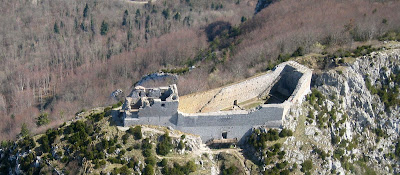It is a social history, also called "history from below," trying to understand the past through research into regular living rather than political or military history, or the lives of prominent figures at the top of the social-political pyramid.
He had a very specific reason for examining that particular place and time. The book was translated into English in 1978 with the subtitle "The Promised Land of Error / Cathars and Catholics in a French Village." The "certain records" mentioned in the first paragraph were those made by the Inquisition, specifically a group of documents called the Fournier Register. This was made by Jacques Fournier, the Bishop of Pamiers, in whose diocese Montaillou lay. This area was one of the last holdouts of the heresy Catharism, and Fournier was determined to eliminate it.
The Inquisition was quite careful in its procedures. During questioning of a subject, a scribe would take short notes. These would then be expanded more fully with the help of the Inquisitor, and the result shown to the questioned for review and edits. The Occitan language would also be translated into Church Latin. The result was a record of hundreds of commoners and their day-to-day observations and opinions.
One example of beliefs is his questioning of Guillemette of Ornolac, who was said to have doubted the existence of the soul. She offered the opinion that the "soul" was really blood, and that death is the end. When asked who taught her this, she replied "No, I thought it over and believed it myself." She was sentenced to wear a cross of yellow on her back for the rest of her life. Of the hundreds questioned—578 sessions, mostly with peasants—his inquisition resulted in only five capital sentences (being burned at the stake).
His thoroughness impressed his superiors, and he quickly advanced through the ranks. And that is why we have these early records so carefully preserved so that Ladurie could comb through them six and a half centuries later: Fournier took them with him when he went to Avignon. Why Avignon? He became pope. Let's take a look at Pope Benedict XII tomorrow.







